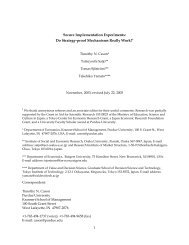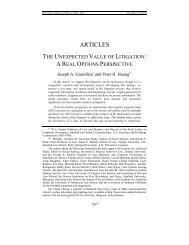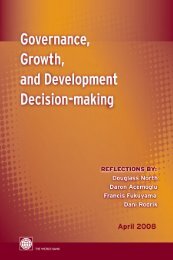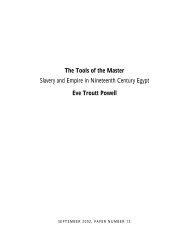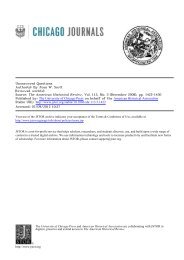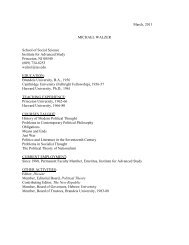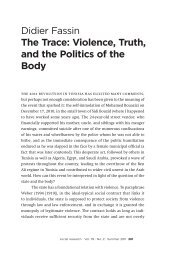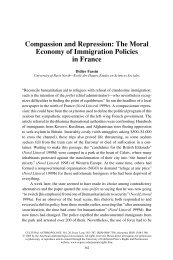Peter H. Huang Harold E. Kohn Chair Professor of Law James ...
Peter H. Huang Harold E. Kohn Chair Professor of Law James ...
Peter H. Huang Harold E. Kohn Chair Professor of Law James ...
Create successful ePaper yourself
Turn your PDF publications into a flip-book with our unique Google optimized e-Paper software.
Emotional Impact Analysis<br />
IV. Conceptual and Measurement Issues with Emotional Impact Analysis<br />
A precursor to EIA is research by Richard Zerbe, Jr. and his co-authors about incorporating moral<br />
sentiments into CBA. 235 Zerbe’s approach confronted and tackled conceptual difficulties and issues about<br />
including moral sentiments in CBA. This Article advocates counting and including not only moral<br />
sentiments in analyzing policy, but also emotional impacts. But Zerbe’s approach bracketed any<br />
discussion <strong>of</strong> measurement issues associated with incorporating moral sentiments into CBA. Fortunately,<br />
many issues that measuring and quantifying emotional impacts have been addressed already in empirical,<br />
experimental, and theoretical research by economists and psychologists about happiness. Indeed,<br />
happiness is an alternative metric to money or wealth for measuring emotional impacts.<br />
There is a variety <strong>of</strong> emotional impacts that EIA might helpfully incorporate, including<br />
distributional or equity concerns, 236 ethical considerations, 237 moral consequences, 238 and process<br />
concerns. 239 But if regulators are to incorporate these affective variables into their policy deliberations and<br />
evaluations, then regulators must be able to consistently quantify or measure such variables in order to<br />
improve upon their decision-making process by adding such affective variables to CBA. Fortunately,<br />
there are several precursors to EIA, including arguably Adam Smith’s first book, The Theory <strong>of</strong> Moral<br />
Sentiments (1759), published seventeen years before his famous book, The Wealth <strong>of</strong> Nations (1776). 240<br />
A. Moral (and Immoral) Sentiments<br />
EIA builds upon research analyzing the desirability and feasibility <strong>of</strong> policy makers taking into<br />
account moral sentiments. Zerbe utilizes the phrase “moral sentiments” to mean concern for other people,<br />
beings, or entities in the form <strong>of</strong> paternalistic or non-paternalistic altruistic preferences. People clearly<br />
feel moral sentiments as defined here. Thus, moral sentiments are particular examples or forms <strong>of</strong><br />
234 See generally Eric A. Posner & Cass R. Sunstein, Dollars and Death, 72 U. CHI. L. REV. 537 (2005).<br />
235 See e.g., Richard O. Zerbe, Jr., Should Moral Sentiments Be Incorporated into Cost-benefit Analysis? An<br />
Example <strong>of</strong> Long-Term Discounting¸ POL’Y SCI. (2006).<br />
236 See generally, LOUIS KAPLOW & STEVEN SHAVELL, FAIRNESS VERSUS WELFARE (2002).<br />
237 See generally, JOHN R. BOATRIGHT , ETHICS IN FINANCE (1999).<br />
238 See generally, BENJAMIN M. FRIEDMAN, THE MORAL CONSEQUENCES OF ECONOMIC GROWTH (2005).<br />
239 F. Thomas Juster et al., A Conceptual Framework for the Analysis <strong>of</strong> Time Allocation Data, in TIME, GOODS, AND<br />
WELL-BEING 113, ? (F. Thomas Juster & Frank P. Stafford eds., 1985).<br />
38



